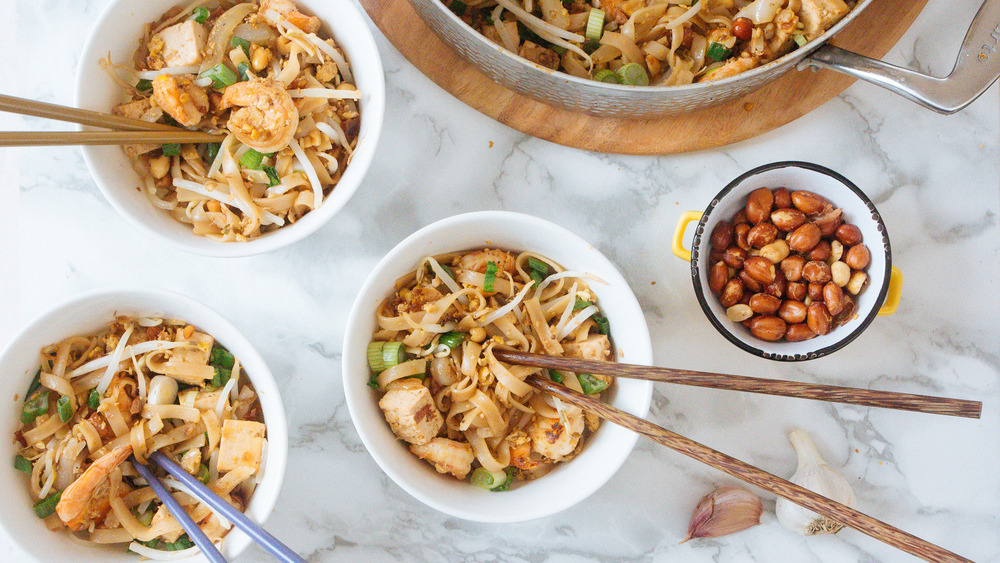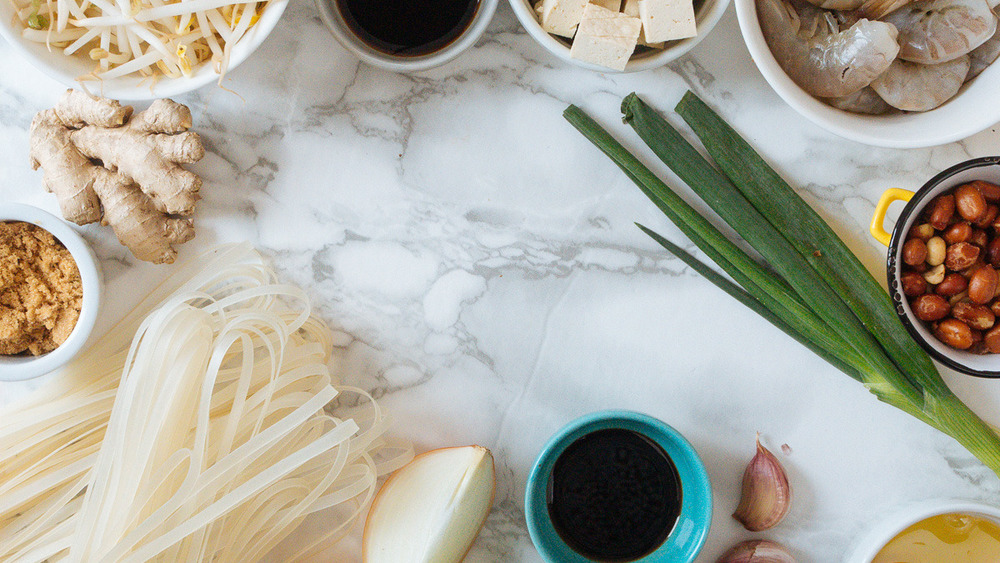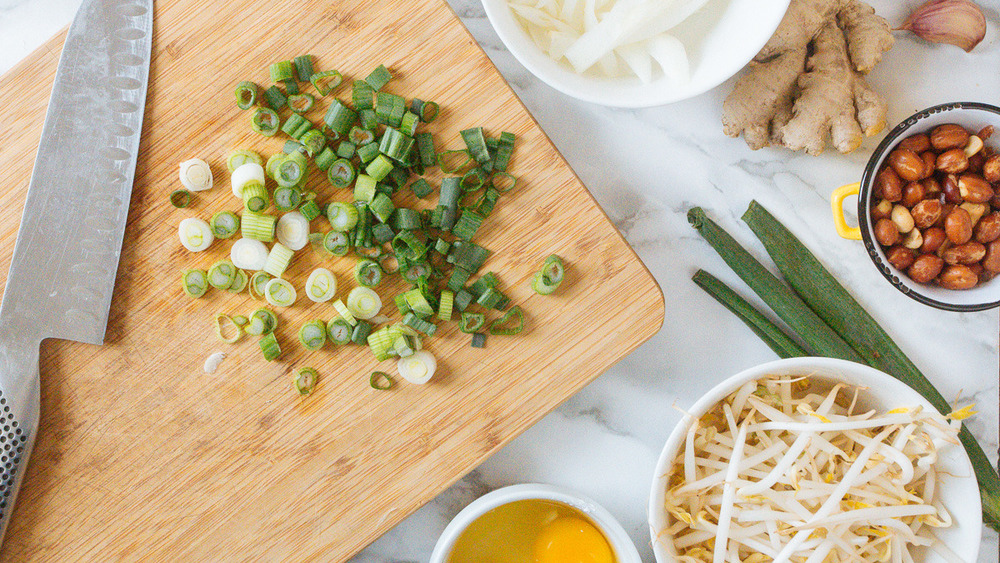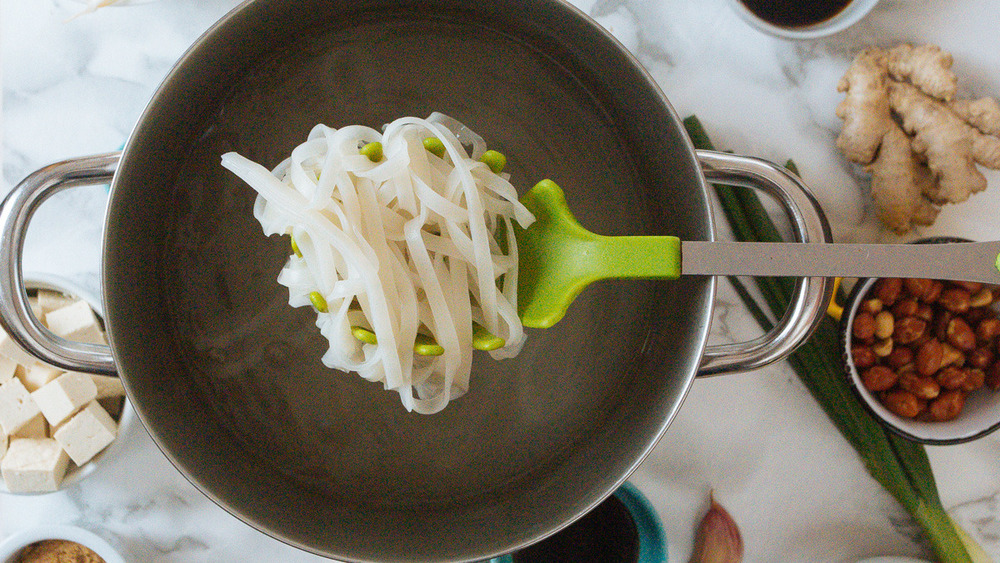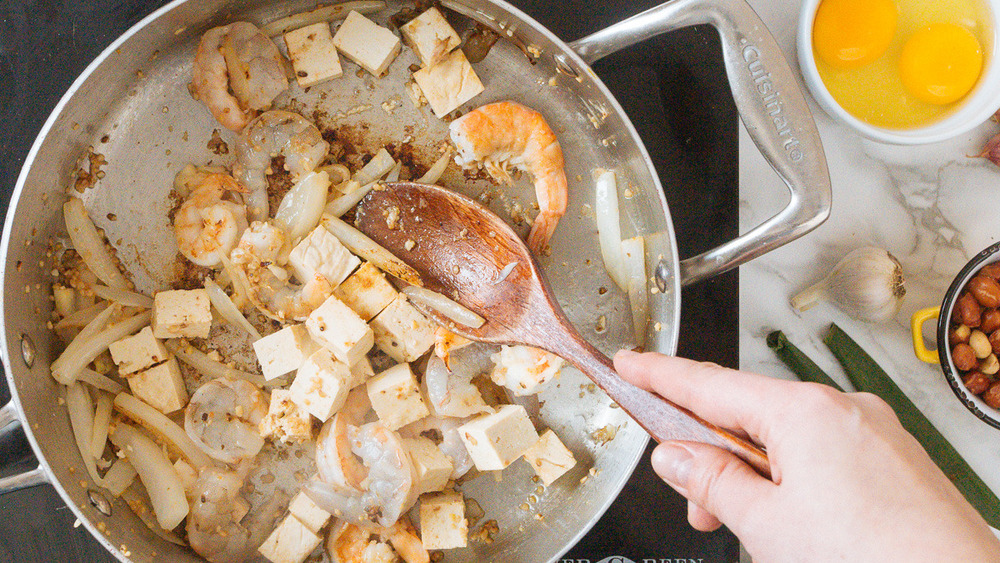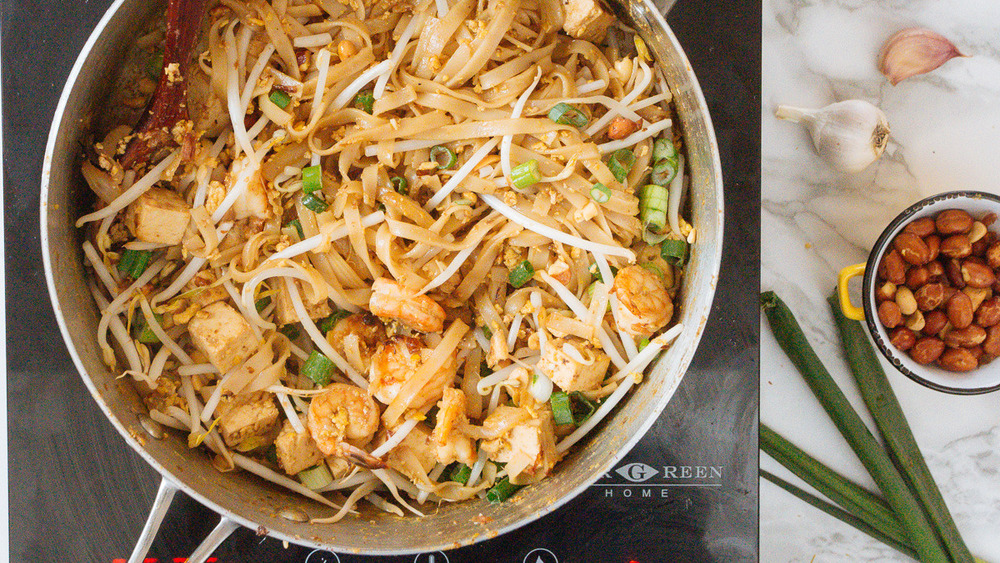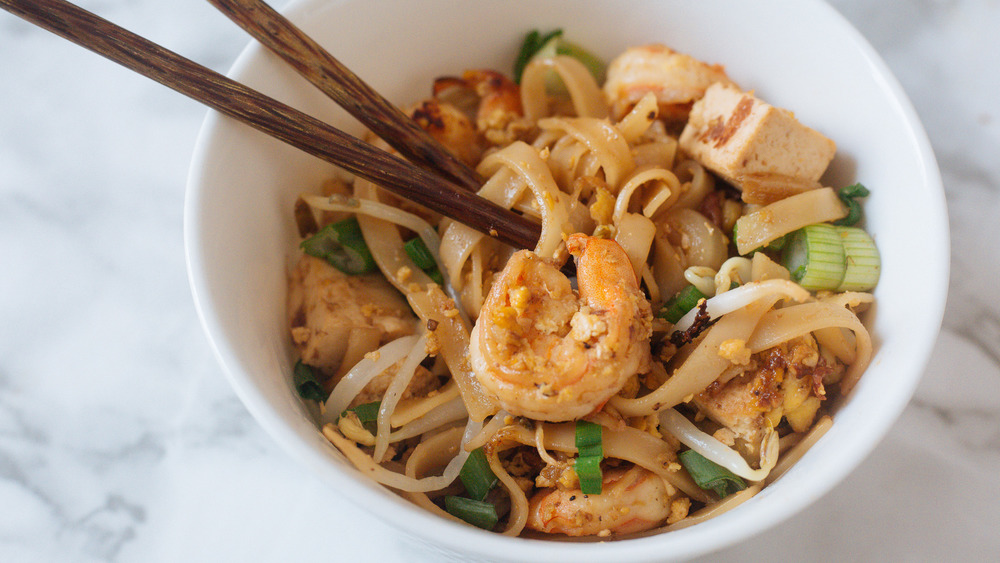Quick Homemade Pad Thai Recipe
Pad Thai is the perfect dish: a balance of noodles, a sweet and tangy sauce, a healthy dose of vegetables and not one, but three choice proteins. Topped with crunchy peanuts and a squeeze of lime, this is a dish you'll want to make again and again.
Probably the most ubiquitous dish of Thailand, pad Thai is a classic for vegetarians and meat eaters alike. But with its carefully struck balance of flavors and simple preparation, there's no reason you shouldn't make this dish at home — especially as it comes together in under 30 minutes!
You may be surprised to learn that the history of pad Thai is quite controversial — and not very Thai, at that. American pad Thai isn't all that authentic and the dish wasn't borne out of long-developed regional flavors; instead, it was invented in the 1930s when Thailand's populist Prime Minister decided the country needed a new national dish, along with a new, more modern national identity. So he renamed the country, imposed a national dialect, and asked his chefs to develop a nutritious and affordable national dish. Rice noodles were abundant, but the rest of the ingredients were borrowed from other cultures — Chinese, Malaysian. and others.
And thus, pad Thai was born. And today, it's hard to imagine Thailand without it.
Gather the ingredients for pad Thai
In our authentic but slightly simplified pad Thai, most of the ingredients are readily available in most major supermarkets. The only one you may be hard-pressed to find is Tamarind puree, but we offer a substitution for it, as well.
To make pad Thai, start with a 4-oz package of Thai-style rice noodles. These are slightly thicker, flat rice noodles; you can also buy Vietnamese noodles as they are virtually the same.
For the pad Thai sauce, you will need brown sugar, fish sauce, soy sauce and tamarind puree. If you cannot find tamarind puree, use 1 tablespoon of ketchup and 2 tablespoons of rice vinegar, instead. For the vegetables, you will need onion, garlic, ginger, bean sprouts, scallions, and a lime. Chopped peanuts provide the crunch factor.
The proteins used in traditional pad Thai are scrambled eggs, tofu, and prawns — though you can also omit the prawns or use chicken in their place (you'll just need to cook the chicken a bit longer at the start.
Prep the pad Thai vegetables and proteins
Once you start cooking, the preparation of pad Thai actually goes very quickly, so it helps to have everything set up and prepped before you start.
Slice the onion into crescent moon shapes. Dice the garlic finely. Grate the ginger on a microplane grater. Cut your lime into wedges and chop or crush the peanuts. Arrange all of them in bowls with each ingredient in its own bowl.
Whisk the eggs in a small bowl with a bit of salt, and set aside. Dice tofu into 1-inch cubes, and set aside. Set prawns and bean sprouts near the stovetop.
Cook the noodles and make the pad Thai sauce
Cook the rice noodles according to package instructions. If your package doesn't have instructions, what you usually have to do is set a large pot of water to high heat, and bring it to a boil. Turn off the heat and remove the pot from the stovetop. Add rice noodles to the pot, and let them soak in the hot water for five minutes, until they are half-cooked. Drain the water immediately, and set the noodles aside.
In a medium sized bowl, mix brown sugar, fish sauce, soy sauce, and tamarind puree (or ketchup and rice vinegar). Set the pad Thai sauce aside.
Cook the pad Thai proteins
Preheat a wok or large pan to medium-high heat. Add 2 tablespoons of oil, minced garlic, sliced onion, grated ginger, and sauté for one minute. Add the prawns (or chicken) and tofu and saute, stirring often, for three minutes or until cooked through.
Moving the proteins to one side of the pan, clear space and add 1 tablespoon of oil to the pan. Add whisked eggs to the pan and, using a spatula, scramble them immediately, breaking them up into little bits. Don't worry if your eggs mix in with the vegetables and other proteins; it's totally normal and won't hurt the flavor or texture of the finished dish.
Stir fry the noodles for you pad Thai
Add the half-cooked rice noodles to the pan, and, using tongs, toss them with the egg and protein mixture. Continue cooking for 3-4 minutes while stirring constantly, until noodles become completely soft and pliable.
Add Pad Thai sauce to pan. Stir until fully mixed and incorporated into the noodles, proteins and eggs. Don't worry if your rice noodles start to break; it actually makes them easier to eat, so it's all good!
Add the bean sprouts and chopped peanuts, reserving a handful of peanuts on the side for later. Stir until everything is well mixed, and remove the pan from the stove's heat.
Serve pad Thai with lime wedges and a squirt of your favorite hot sauce
Transfer pad Thai to a large serving platter or bowl immediately — the sooner you serve the pad Thai after cooking, the better it tastes! Top pad Thai with more scallions and reserved chopped peanuts, and with a few lime wedges on the side. You could also serve an Asian hot sauce of your choice, like Sriracha, on the side.
Leftover pad Thai will keep in a well sealed container in the fridge for four days. However, keep in mind it will start to harden and lose some of its flavor as it sits. The best pad Thai is eaten fresh out of the wok, like in Bangkok's floating markets.
Now that you've tasted fresh pad Thai from your very own kitchen, you'll know how easy it is to replicate what you're missing — and never order it in again.
Directions for pad Thai
This pad Thai recipe appeals to both vegetarians and meat eaters alike. It's easy to put together and so good you may just toss out those Thai takeout menus.
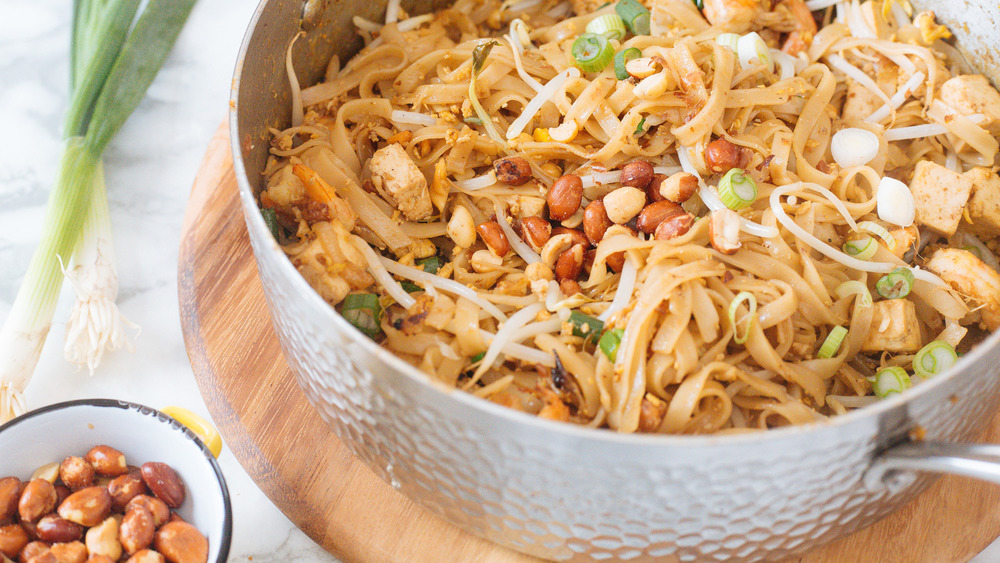
Ingredients
- 1 package of Thai-style rice noodles
- 1.5 tablespoons of Tamarind puree OR 1 TB of ketchup + 2 TB rice vinegar
- 3 tablespoons of brown sugar
- 3 tablespoons of fish sauce
- 1 tablespoon of soy sauce
- 1/2 onion
- 2 cloves of garlic
- 1-inch piece of ginger
- 2 eggs, whisked
- 1 cup (4oz) extra firm tofu, cut into 1-inch cubes (
- 1 cup (4.5oz) peeled, deveined prawns
- 1.5 cups of bean sprouts
- 1/2 cup of chopped peanuts
- 1/4 cup chopped scallions
- 1 lime, cut into wedges
Directions
- Set a large pot of water to high heat, and bring it to a boil. Turn off and remove from stovetop. Add rice noodles to pot, and let them soak for 5 minutes. Drain water immediately.
- In a medium sized bowl, mix brown sugar, fish sauce, soy sauce, and tamarind puree (or ketchup and rice vinegar). Set the pad Thai sauce aside.
- Preheat a large pan or a wok to medium-high heat. Add 2 tablespoons of oil, garlic, onion and ginger, and sauté for 1 minute. Add prawns and tofu and sauté, stirring often, for 3 minutes or until cooked through.
- Moving the proteins to one side of the pan, clear space and add 1 tablespoon of oil to pan. Add whisked eggs to pan and, using a spatula, scramble them immediately, breaking them up into little bits.
- Add half-cooked rice noodles to the pan and toss with the egg and protein mixture. Continuing cooking for 3-4 minutes while stirring constantly, until noodles become completely soft and pliable.
- Add pad Thai sauce to pan. Stir until fully mixed and incorporated into the noodles, proteins, and eggs.
- Add bean sprouts and chopped peanuts, reserving peanuts some on the side for later. Stir until everything is well mixed, and serve remove from heat.
- Top with scallions and additional chopped peanuts, and with a few lime wedges on the side. You can serve an Asian hot sauce of your choice, like Sriracha, on the side. Serve immediately.
Nutrition
| Calories per Serving | 272 |
| Total Fat | 5.9 g |
| Saturated Fat | 1.0 g |
| Trans Fat | 0.0 g |
| Cholesterol | 48.1 mg |
| Total Carbohydrates | 44.7 g |
| Dietary Fiber | 2.3 g |
| Total Sugars | 4.9 g |
| Sodium | 707.5 mg |
| Protein | 10.3 g |
